Tottenham Hotspur finished their season in the Premier League in eighth place, which was a huge disappointment for their fans, but the season could have ended worse if not for set pieces, especially corners.
Gianni Vio was working as a set-piece coach within the technical staff of Tottenham with his compatriot Antonio Conte and continued in Tottenham after his departure.
Gianni Vio, who was Italy’s secret weapon in Euro 2020, achieved great success with Tottenham. Despite their bad situation this season, it is enough to know that nobody scored more goals from corners than Tottenham this season with 12 goals, level with Arsenal. In set pieces generally, they scored 16 goals, in second place for the team that scored the most goals from set pieces in the Premier League level with Brentford and just below Liverpool with 17 goals.
Spurs scored 70 goals in this Premier League season, 16 of them from set pieces with a percentage close to 23%, which is a number that is not easy.
There is no doubt that Spurs have a squad full of tall and strong players in aerial duels such as Harry Kane, Eric Dier and Ben Davies, who is one of the smartest players in moving and escaping from man-marking. We shouldn’t forget Ivan Perišić and Emerson Royal, who are distinguished by their ability to get the first touch.
However, as we will see in this set-piece analysis, we can not deny the role of the technical staff, represented by Gianni Vio, who distributed the roles and designed the routines and, most importantly, always changed his strategies to be difficult to predict.
This tactical analysis will discuss different routines that Tottenham Hotspur used in attacking corners in this Premier League season.
Flicks
Here, in this next example, Newcastle defend with two zonal markers (highlighted in green). Miguel Almiron is there to defend the short corner if it happens while Joe Willock defends the rebound zone. The remaining six players act as man-markers.
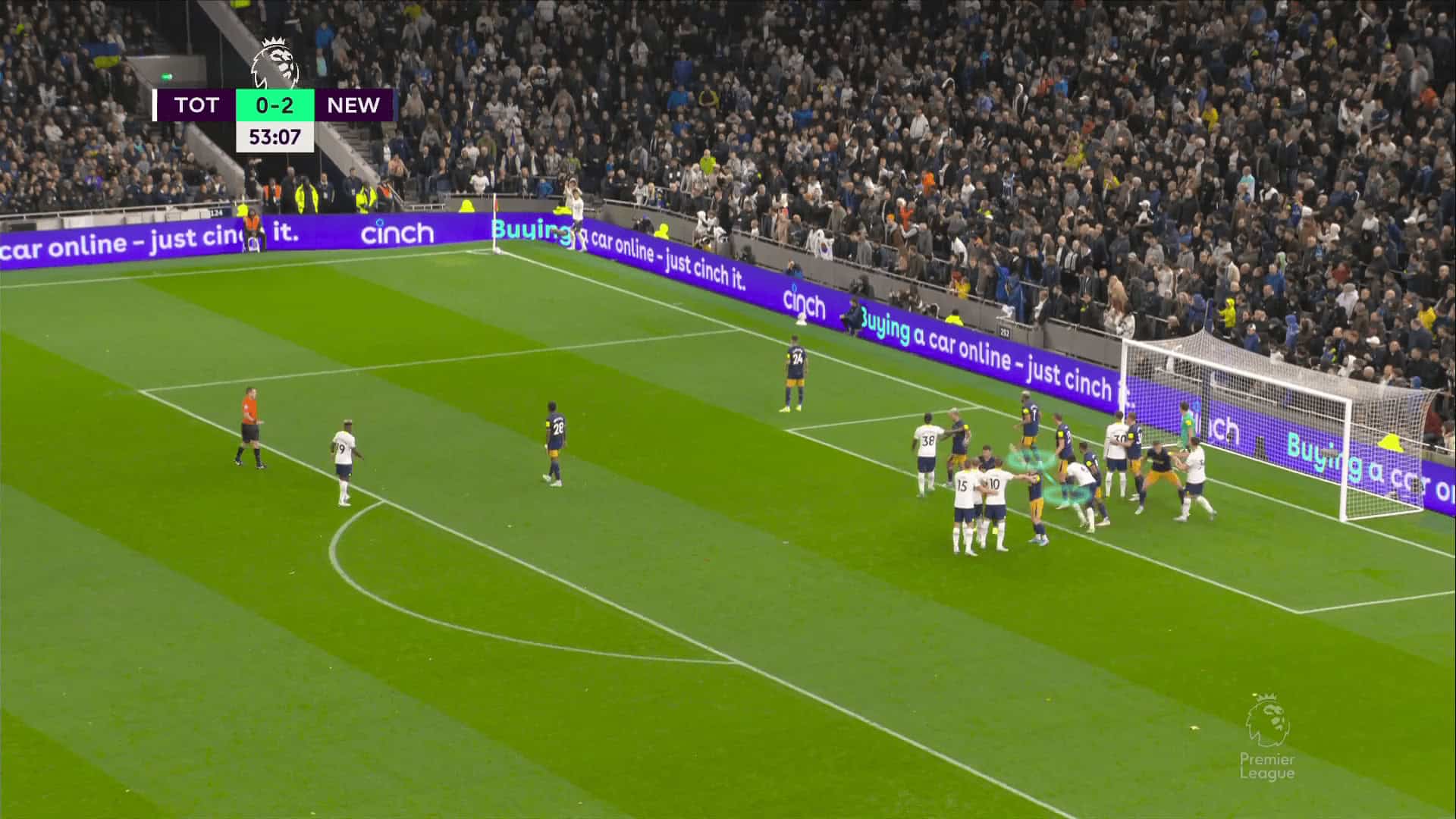
Clement Lenglet, with the green arrow, is the player who flicks the ball in this routine, so as the taker prepares to play, he starts moving with a curved run around the goalkeeper, using him as a screen to win a battle before his marker comes from Joelinton’s blind side. You can notice that there are seven players of Tottenham against six markers, so Eric Dier with a yellow arrow runs towards the near post to hit the ball if the ball passed Lenglet using Oliver Skipp as a screen.
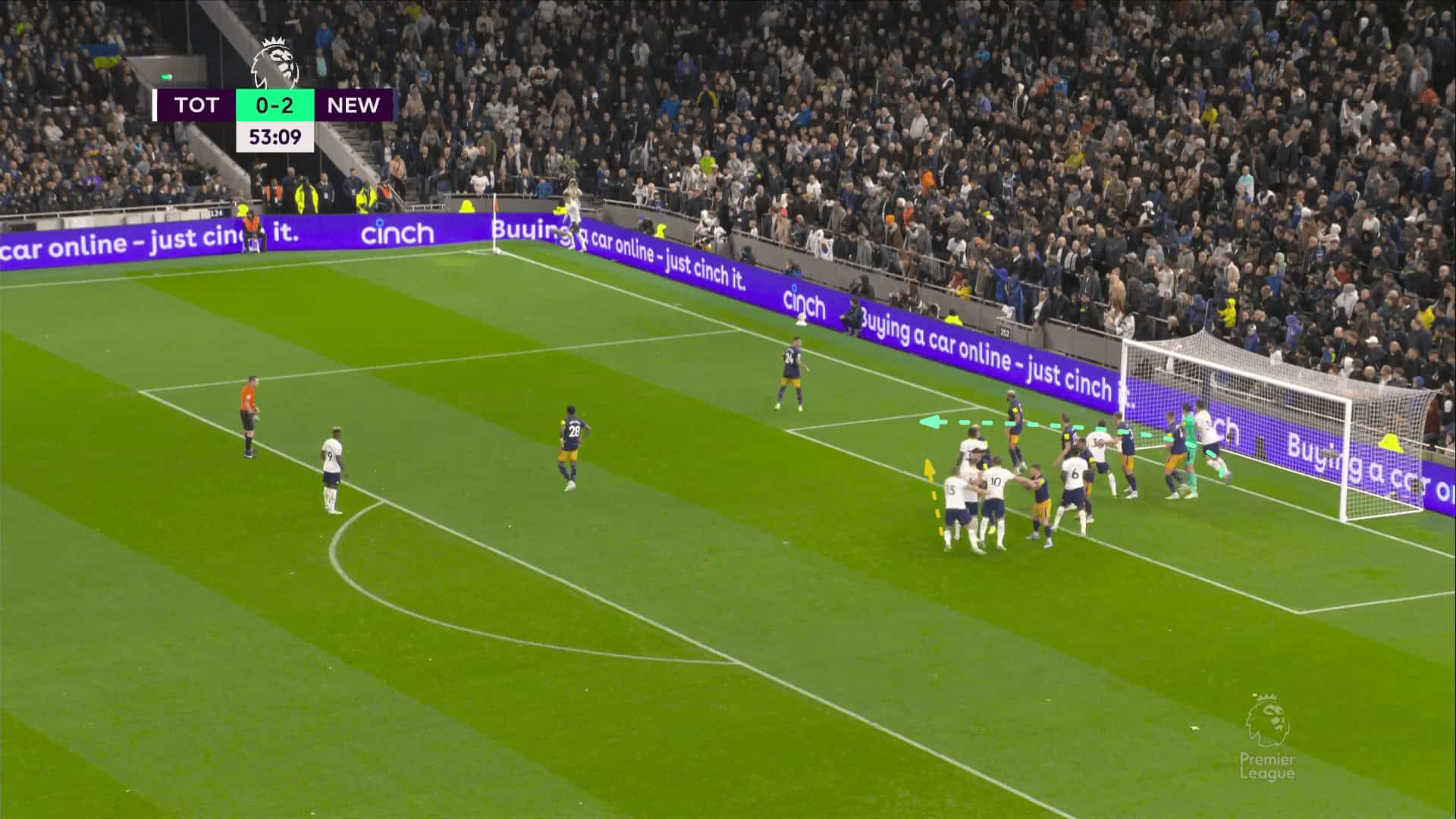
To make sure that Lenglet can get the ball, Spurs need to block the two zonal markers we have mentioned, so when the taker prepares to move, Rodrigo Bentancur goes to block Joelinton (the yellow arrow) and Davinson Sanchez blocks Burn (the green arrow).
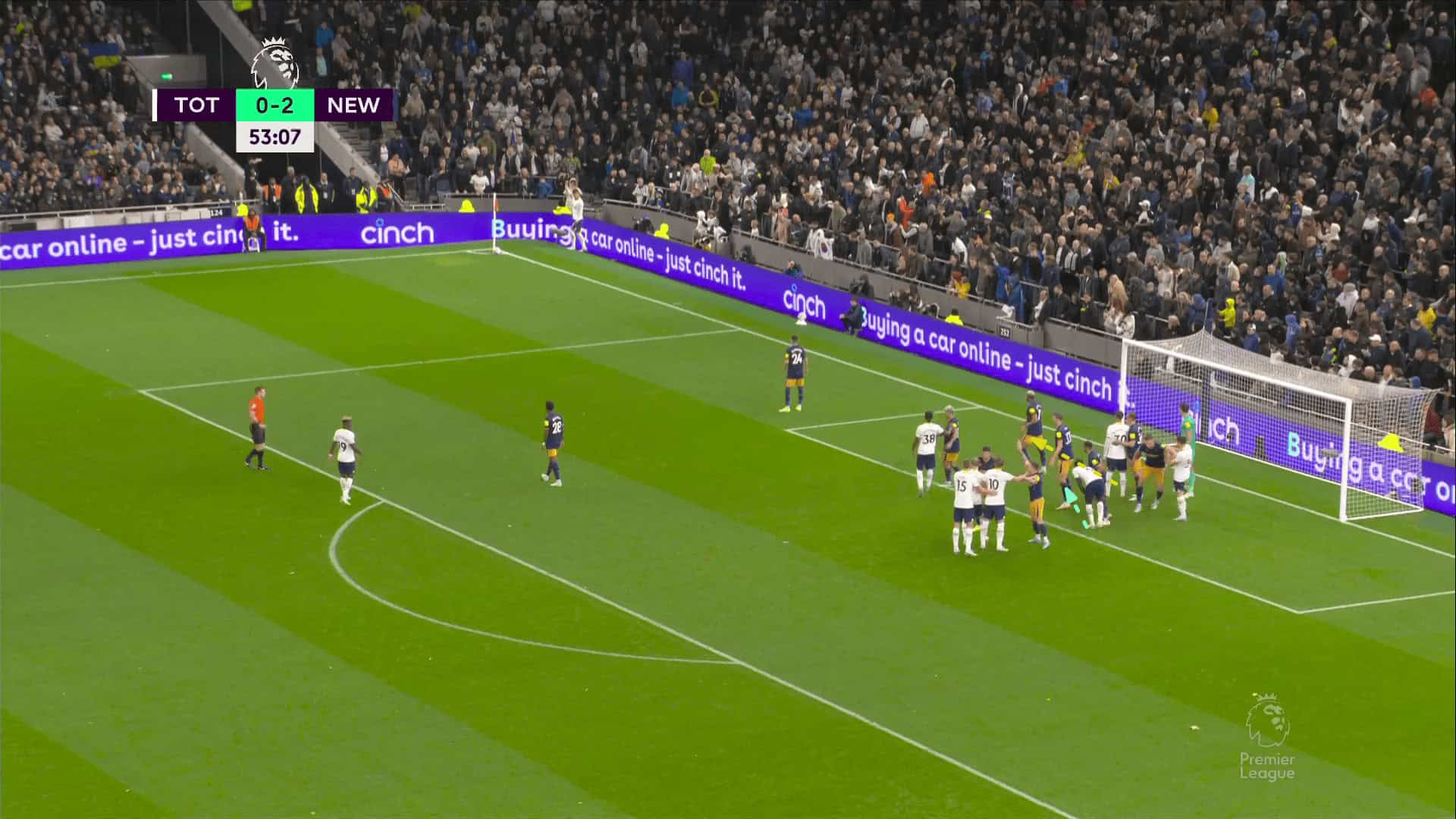
Here, the two blocks we have mentioned are highlighted in green. Skipp, with a yellow arrow, returned to the rebound zone after having previously been performing the screen and Yves Bissouma, with a red arrow, dragged his marker back to empty the area in front of the far post for Harry Kane.
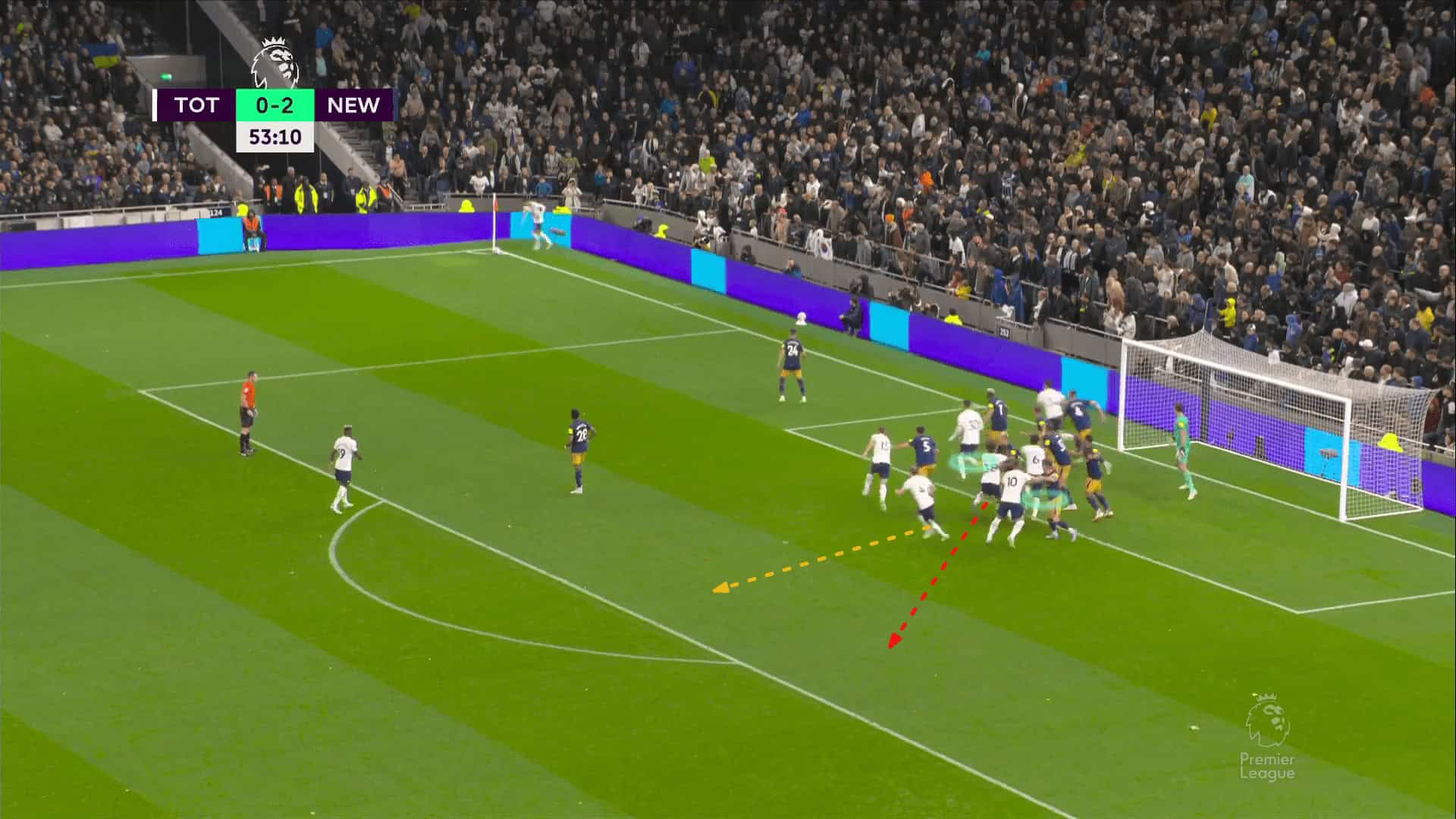
Here, we can see the two blocks we have mentioned happen in green. Skipp, with a yellow arrow, returned to the rebound zone after doing the screen and Bissouma, with a red arrow, dragged his marker back to empty the area in front of the far post for Kane.
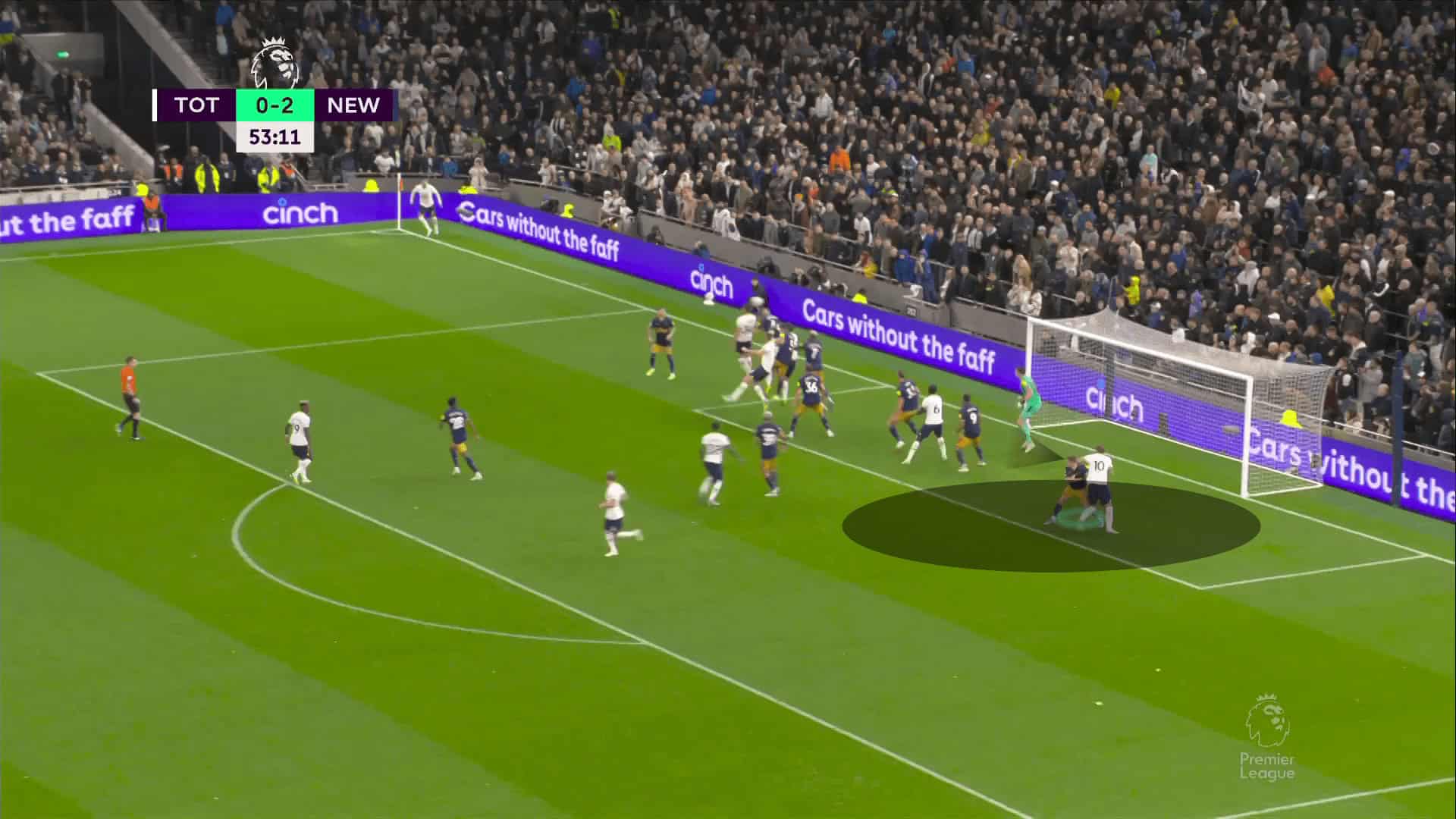
Here, Kieran Tripper turns towards Harry Kane, losing connection with the ball. The second principle applied here is “mismatch” because if you put Kane in a 1v1 situation, he will have superiority.
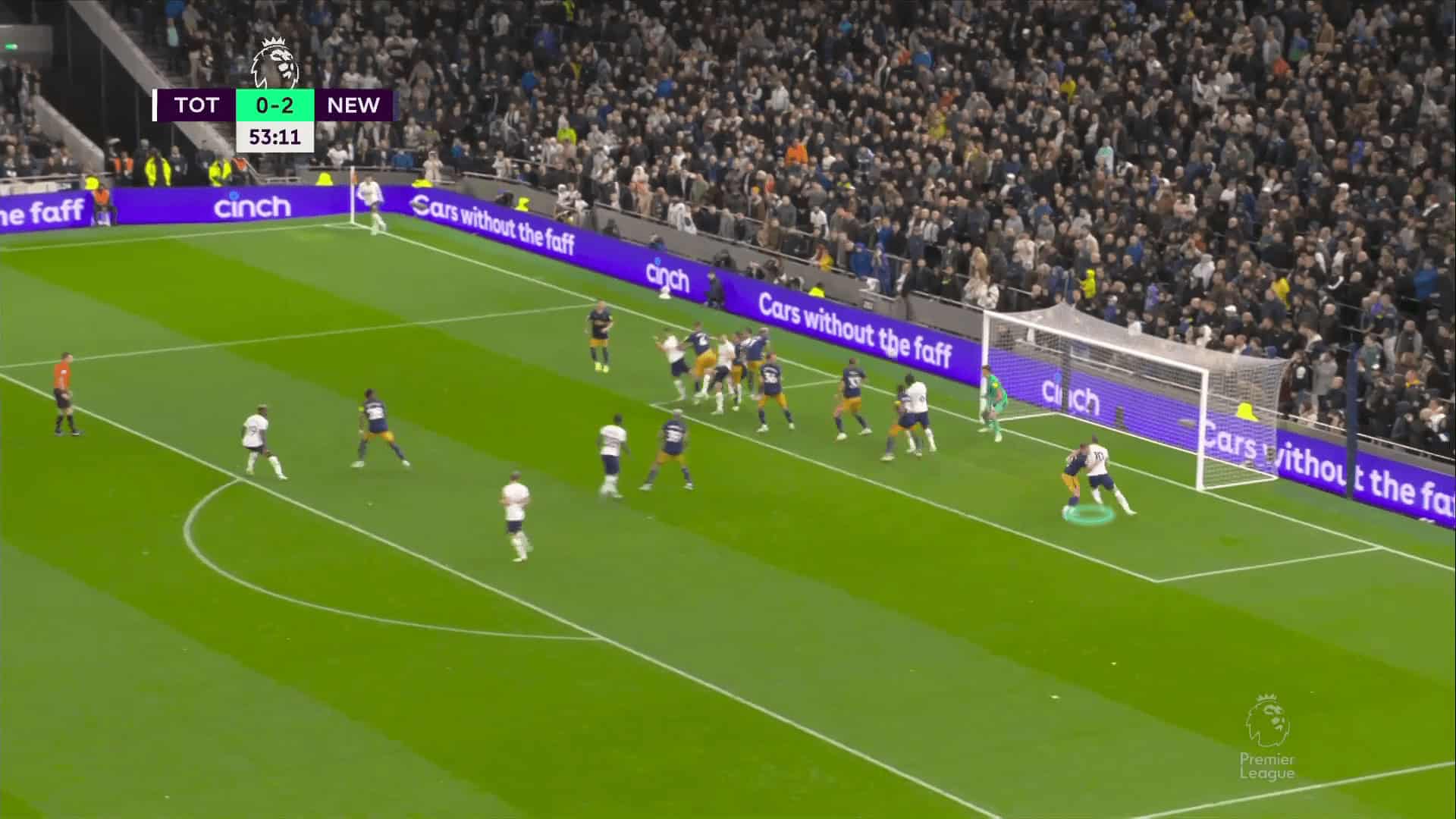
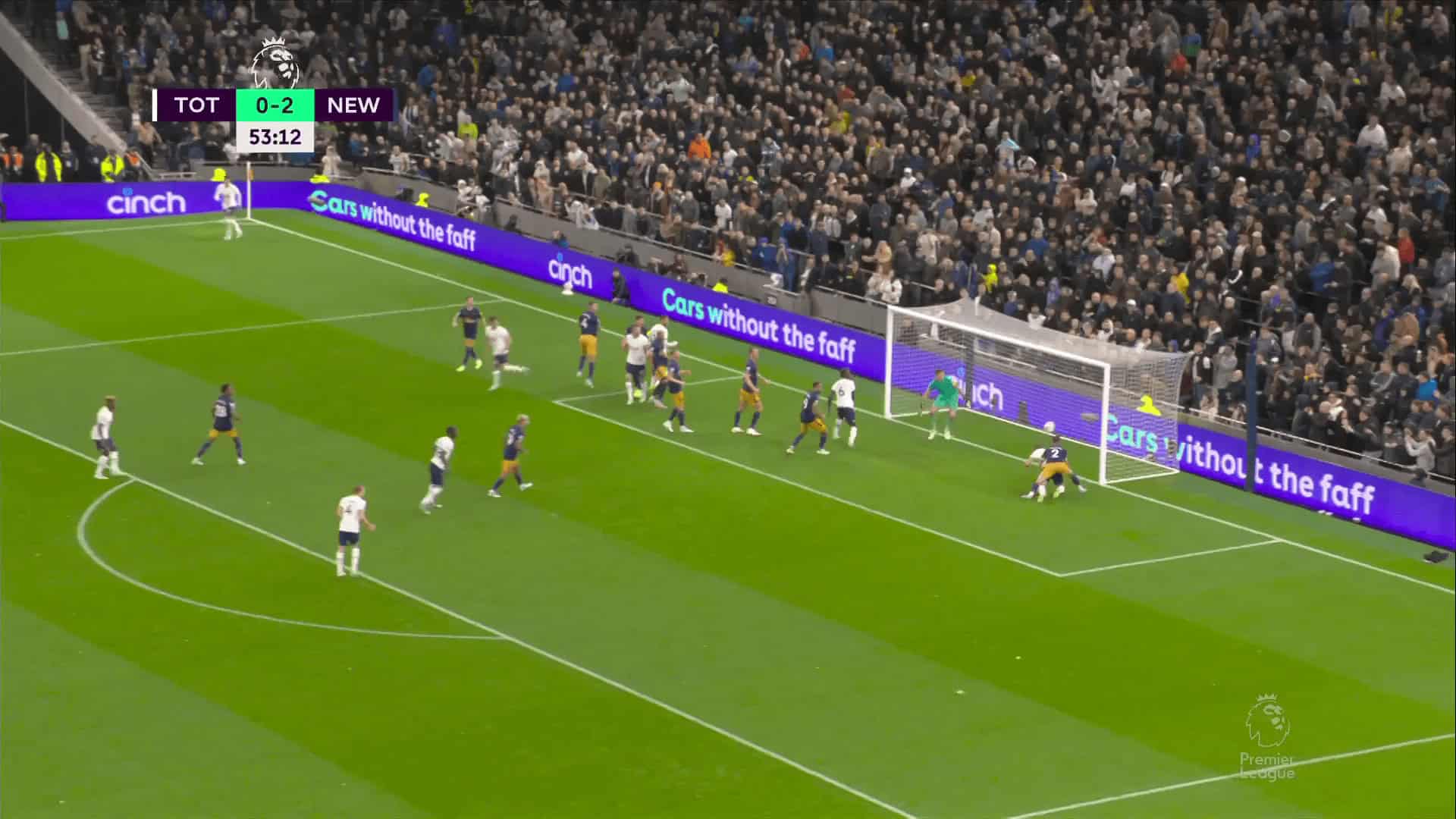
Again here, Tottenham have another brilliant idea against Wolves, so let’s start with the defensive scheme of their opponents. As shown below in the first photo, they defend with two zonal players, but they add an additional player in front of them to defend the flick-on, which are the three in green, and the rest are man markers. Rodrigo Bentancur, with a blue arrow, runs to the edge of the box to allow Ben Davies, with a black arrow, to use Bentancur’s marker as a screen to escape from his marker in a curved run.
In the second picture, when the taker started moving, Davies runs in a curved path, highlighted in green, while Ivan Perišić, who will do the flick with a black arrow, starts moving from the blind side of the defender who stands to defend the flick. In the same photo, Eric Dier, in blue, pushes his marker to go to the second zonal player to block him, as shown in the third photo in blue.
In the third photo, Perišić flicks the ball while Davies, in green, goes to the shaded space to get the ball if Perišić can’t. Maybe it was the plan to make Perišić drag the first zonal man with a fake flick movement while Dier blocks the second one to empty the space for Davies and it is one of their strengths that they overload the space around the targeted area as will be discussed later. Davinson Sánchez, in yellow, moves to the middle, dragging his marker away from the far post.
Harry Kane steps outside to ensure that his marker sees him, then moves to the far post after Perišić’s touch which causes a problem in orientation that makes the defender unable to see the ball and his opponent at the same time as shown in the fourth picture.
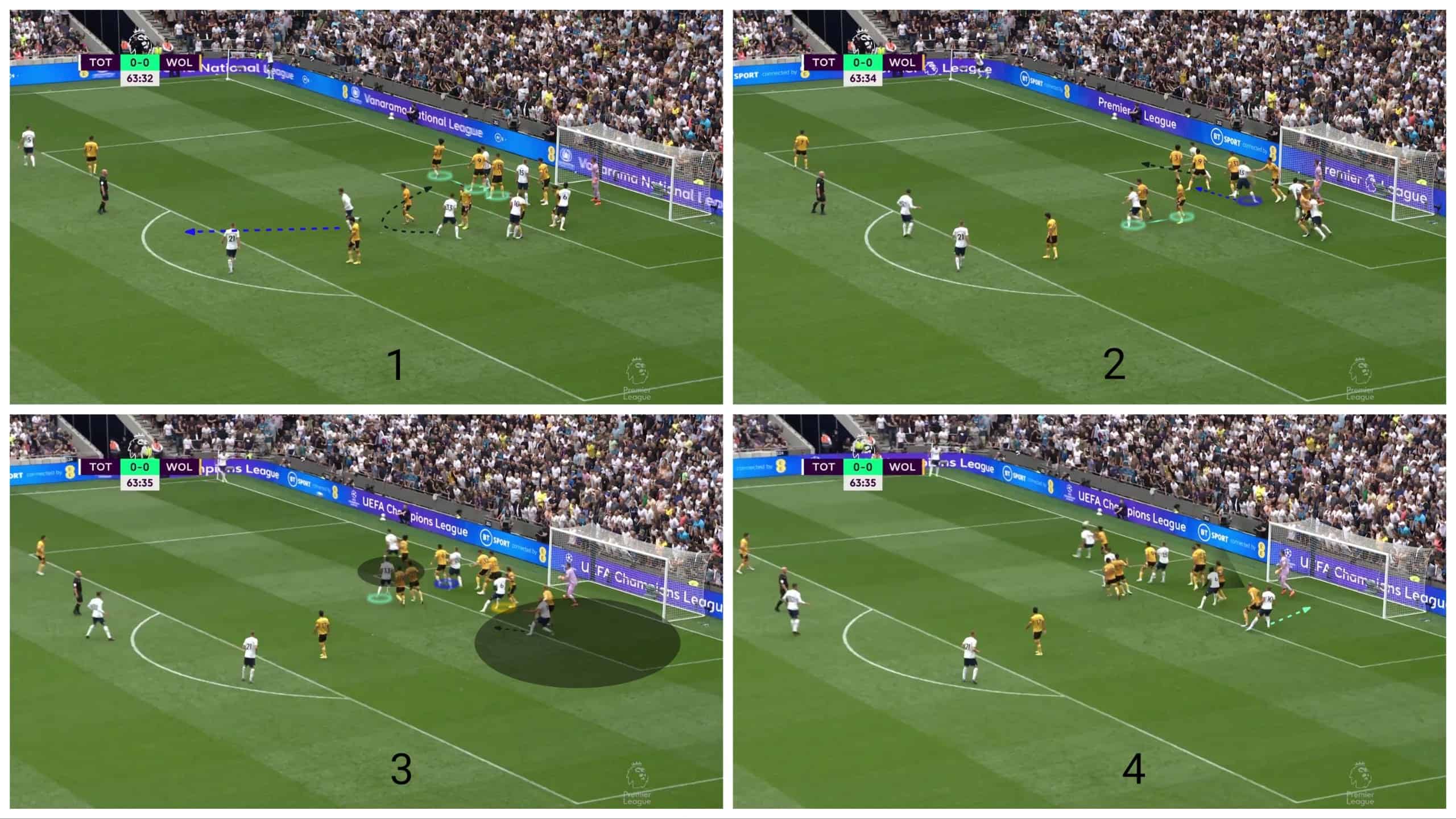
Fake flick to target the near post
Here, Chelsea defend with four players in the first zonal line, as shown with black numbers, two players, in green, in the second zonal line, two players, in red, to defend the short option and the rebound zone and two man markers, highlighted in yellow.
One of them marks the opponent’s player who stands in front of the goalkeeper behind the first zonal line, who is Dier in this case, while the second marks the opponent’s runner in front of the second zonal line, who is Lucas Moura in this case.
In the second photo, Tottenham’s target is to empty the space behind Thiago Silva, the second player in the first zonal line. This happens through three main movements. Two players, with green arrows, move in front of Silva, showing that the aim is to flick the ball which makes Silva move forward, leaving a space behind him. To make sure that Kalidou Koulibaly won’t cover him, the yellow player stands there to fix him.
In the third photo, two players, with yellow arrows, move to the targeted area with Kane between the two green defenders because, as we said above, overloading is an important principle in Spurs’ routines to increase the probability of getting the first touch as shown in the fourth picture.
The result is an important goal.
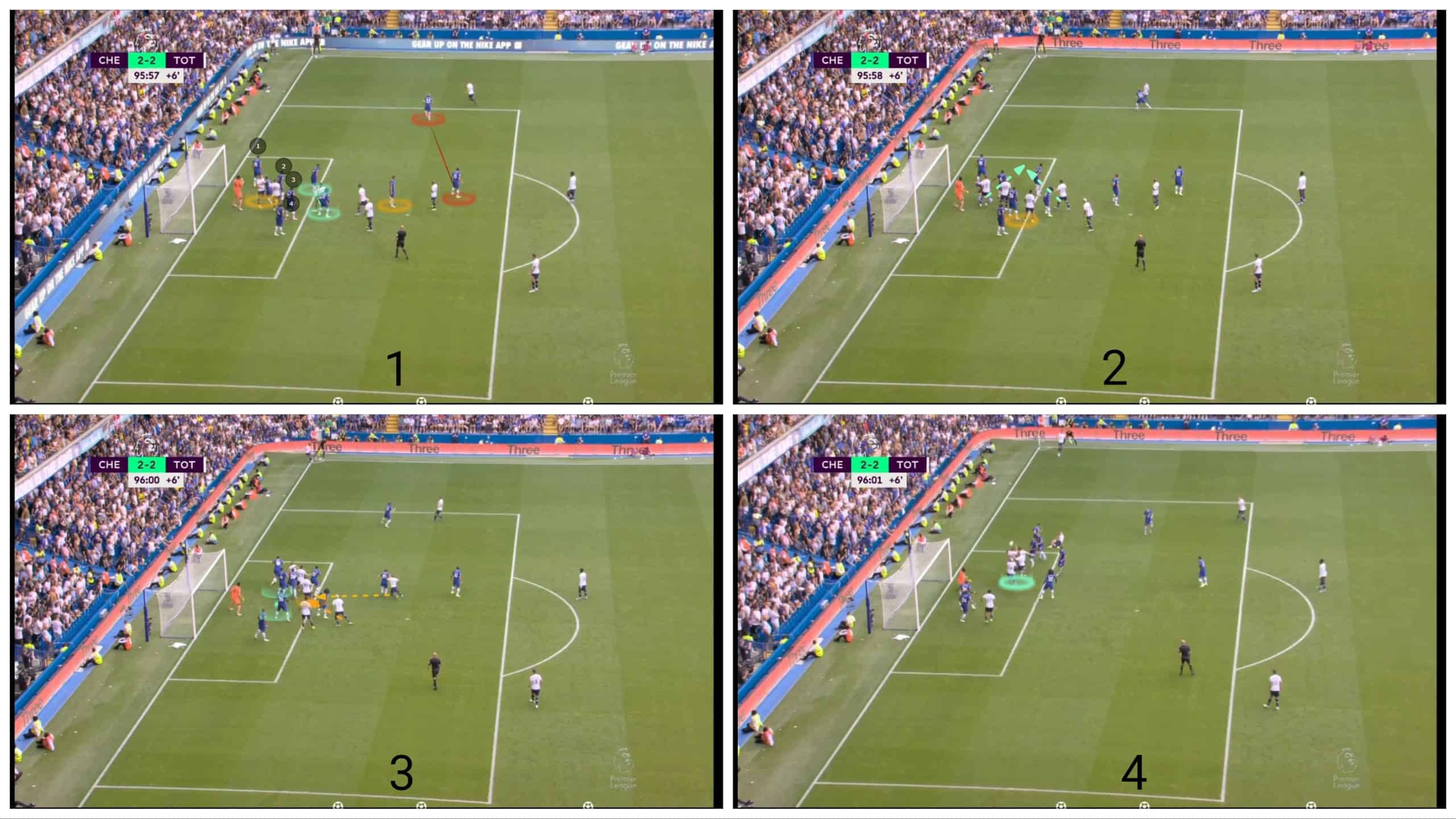
Short corners to target the far post
Gianni Vio’s side sometimes uses short corners to move the organised zonal line which causes a malfunction in the opponent’s scheme during the reshaping. The target is to empty the far post by dragging the man markers away, which is easy, but the trick is how to deal with the zonal players.
In this case, Leicester City defend with four players in the first zonal line as shown in the first photo. The first one has a duty to defend the short corner if it happens, and that is what happens with Perišić. There are only three left in the zonal line.
The second photo shows four players standing in a vertical line who moves in different directions when the short corner is played. Davies, with a green arrow, moves to the near post while Sanchez, with a yellow arrow, moves to stand in front of the last player in the zonal line to take his attention away. Harry Kane and Richarlison move to the far post, highlighted with black arrows.
The third photo shows the position of Sanchez, in green, standing in front of the last player in the zonal line to make the space empty behind him for Kane and Richarlison, highlighted in yellow. Dier and Sanchez are at the near post to drag their markers and two players in the zonal line in a 4v2 situation to make the far post emptier.
There is no longer any problem for Kane and Richarlison except for their two markers. Here, we have two principles: mismatch and orientation. Kane is clever in movement and has the power to win the aerial duels and this is the mismatch. His marker also has a problem in orientation as he can’t see the ball and Kane at the same time. Richarlison also has a role to help him which is to stand sticking to Kane’s marker to take his attention away and also to overload the targeted area.
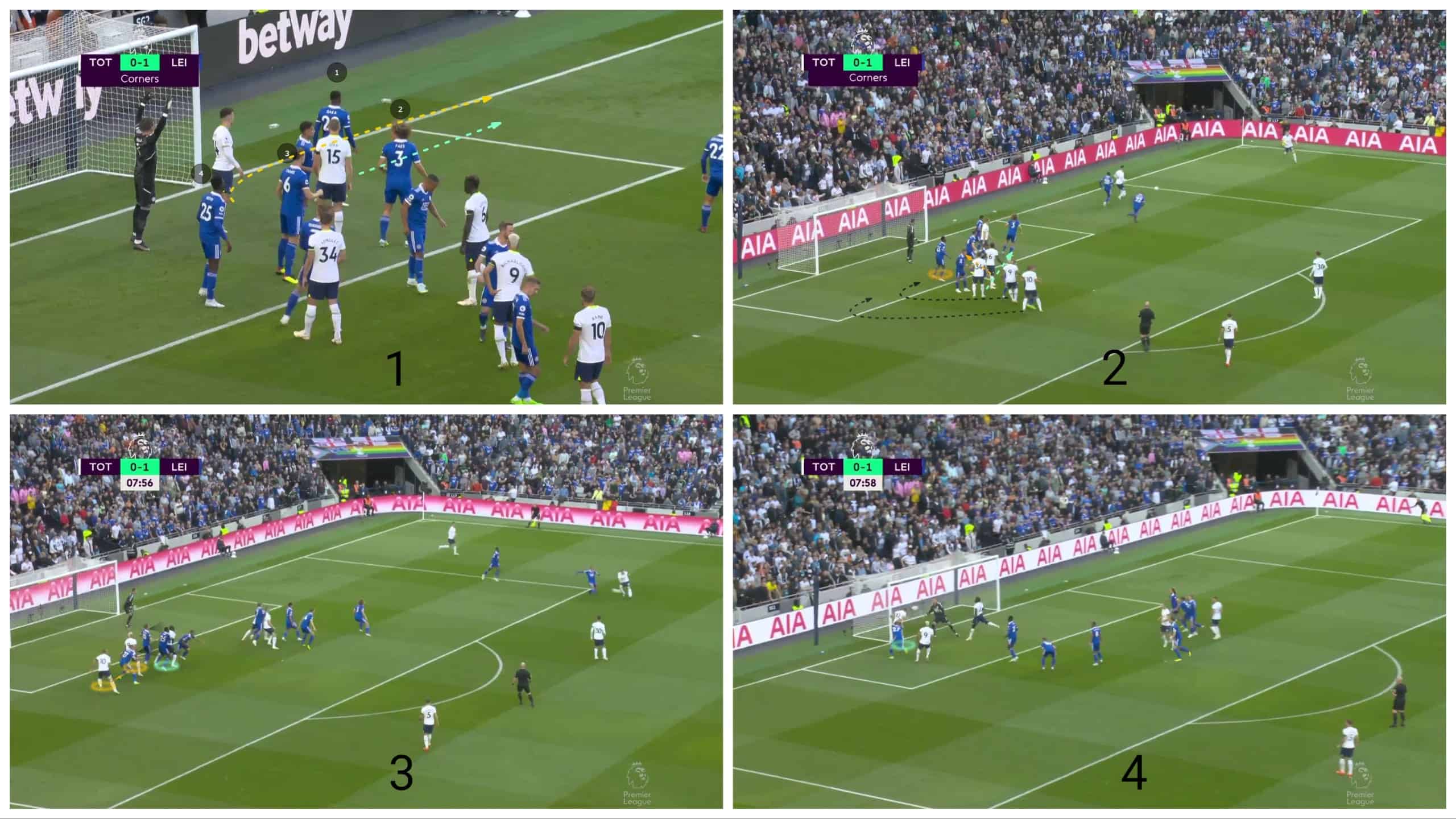
Conclusion
This analysis shows how set pieces were a deadly weapon for Tottenham because of their set-piece specialist, Gianni Vio, and his employment of his players’ excellent abilities in aerial duels.
The corners were the most important weapon for Tottenham in completely unexpected set-piece tactics. When the opponent secures the flicks, Spurs targeted the space behind them on the near post directly. When they secured the near post, Spurs targeted the far post and when the opponent spoiled his plan, they used short corners to disrupt the system.






Comments